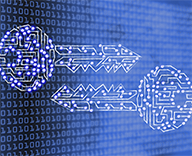
Cryptography

Symmetric

Asymmetric

Hashes
What Is Cryptography?
Cryptography is the process of protecting your information and communications through codes, so only the people that have these codes can access it. Secure information and communication techniques are derived from mathematics and algorithms that will transform your messages into undecipherable information without them.
Cryptography can be associated with scrambling images, which can be done with microdots or merging words with images to hide information between multiple parties. However, the most common method of cryptography is associated with scrambling plaintext (cleartext) into ciphertext (encryption) and then back again when the proper code is received (decryption).
The History Of Cryptography
Cryptography and its origins date back to ancient times, with the first evidence of cryptographic messages being used in ancient Egypt in the hieroglyphs over 4000 years ago. In ancient Greece, the basic mono-alphabetic substitution came along during 500 to 600 BC. Modern cryptography originated amongst the Arabic people in 700 AD, where they used cryptographic messages in the form of permutations and combinations to conceal the meaning of their message. Only holders of the codebook could uncover the secrets behind it.
Medieval England took it a step further between 800-1100 AD, where substitution chipers were applied by scribes to encode their notes and riddles. At that point, Egyptian and Arabic experts such as Ahmad al-Qalashandi and Ibn al-Durayhim all added work in cryptography, specifically substitution and transposition. Cryptography had its start, and places in Mongolia and Europe (specifically England and France) only served to take it a step further.
Cryptographic ciphers began to be applied to the battlefield, seen specifically in World War 1, as armies began to use encrypted codes to battle the opposition. Code-breakers were enlisted, and anyone who managed to crack the enemy's code had a significant advantage. World War 2 only served to evolve cryptography as mechanical and electromechanical cipher machines were in wide use. One of the most famous during this time is the Germans’ Enigma code machine.
The cryptography used today began around 1990 with the invention of the Internet, which demanded wider use of encryption. In the early 2000s, the Advanced Encryption Standard was invented for financial data or anything sent over the Internet.
Types Of Cryptography
Symmetric
This works on a single private key, so the sender must share this key with the receiver, or else they will not have access to the data or the information.
Asymmetric
This encryption involves having two encryption keys. One public and one private. The public is shared with anyone, but the private key is crucial as it is secret and required to decrypt your information. Your encrypted information is put in that state using the public key, but it cannot be accessed without the private one, like a double-locked box.
Hashes
After selecting your encryption of choice, hashes ensure that your data is not altered but is authentic and verified. This one-way function converts data into small standard-sized data with a unique fingerprint that proves your data has not been altered in each level of encryption.
How Can Cryptography Help My Business?
The advantages of this come down to four simple principles for your business:
- Confidentiality: The information you need to share securely will never be understood by anyone you did not intend to share it with.
- Consistency: Your information cannot be altered while it is stored or when it is being sent without you being notified of the alteration.
- Proof of Use: Then sender and creator cannot deny any intentions in message creation or transmission.
- Authentication: The sender and receiver can easily confirm each other’s identity, the information’s origin, and its destination.
How Can LT3 ATG Implement Cryptography?
At LT3 ATG, we understand the value cryptography can have for your business from security, consistency, and authenticity perspectives. We have the experience of implementing this technology for multiple clients that benefit from it every day. If you need a cryptographic advantage in your business model, book your consultation with us today!
Cryptography
Related Services
Related Articles
No related articles at the moment
Related Projects
Check out our other projects →LT3 ATG
Ready to get started?
Building your vision starts with a conversation. We're always happy to chat.














